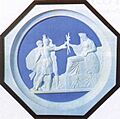Fyodor Tolstoy (artist) facts for kids
Quick facts for kids
Fyodor Tolstoy
|
|
|---|---|

Count Fyodor Tolstoy by Sergey Zaryanko (1850)
|
|
| Born |
Fyodor Petrovich Tolstoy
|
Count Fyodor Petrovich Tolstoy (Russian: Фёдор Петрович Толстой; 21 February 1783 – 25 April 1873) was a famous Russian artist. He was the Vice-President of the Imperial Academy of Arts for 40 years. His art included wax-reliefs, watercolors, medallions, and silhouettes. They are known for their calm and simple classical style.
Contents
A Talented Russian Artist
Early Life and Education
Fyodor Tolstoy came from the well-known Tolstoy family. His father, Count Pyotr Andreyevich Tolstoy, worked for the war ministry. Fyodor started painting very young, guided by his mother. His first drawings, made when he was only four, are now kept in the Tretyakov Gallery.
At nine, he went to live with his rich cousin, Count Pyotr Aleksandrovich Tolstoy. A year later, Fyodor joined the Jesuit College in Polotsk. There, he studied painting and other subjects. When Emperor Paul I became ruler, Fyodor returned to his parents. His family faced harder times because his father lost his job.
From 1798 to 1802, Fyodor studied at the Naval Cadet Corps. After that, he continued learning from famous scientists. He studied mathematics, astronomy, zoology, and more. He also became a skilled horseman.
Becoming an Artist
During this time, Fyodor painted still lives, portraits, and landscapes on his own. When his father showed him a cameo of Napoleon, Fyodor became interested in making medals. He took classes at the Imperial Academy of Arts. One of his teachers was Orest Kiprensky, a popular Russian portrait painter.
In 1804, Fyodor Tolstoy became an assistant to Admiral Pavel Chichagov. He later left this job. From 1806, he worked at the Hermitage Museum. He created artworks like Confidence of Alexander of Macedon to doctor Philippos. In 1809, he made a wax bas-relief called Triumphal entrance of Alexander of Macedon into Babylon. This work helped him become an honorable member of the Academy of Arts.
Famous Medals and Illustrations
Starting in 1810, Fyodor Tolstoy worked at the Mint Department. He became a key figure in medal-making in Russia. After the battle of Leipzig, he began a famous series of 24 medallions. These medallions showed important battles of the Napoleonic Wars.
Tolstoy's medallions became very well-known in Russia and other countries. He was even chosen as a member of many European art academies. In 1861, he made his last medal, celebrating the end of serfdom (when peasants were freed).
From 1820 to 1833, he created 63 illustrations for the book Dushenka by Ippolit Bogdanovich. He used a style called "Neoclassical," which means refined outline drawings without shading. Tolstoy also painted indoor scenes with clear lines and classical statues. His Family Portrait (1830) shows his interest in people's feelings and how light and shadows work.
Other Talents and Recognition
Fyodor Tolstoy was also interested in helping people learn. He helped set up "Lancasterian schools" to teach people to read. He was friends with the founders of the Decembrist societies, but he did not join their failed uprising.
In 1838, Tolstoy wrote a ballet called The Aeolian Harp. He created the story, designed costumes, and planned the dances in over 60 pictures. In 1842, he wrote another ballet, Echo, based on Greek myths. Sadly, neither ballet was ever performed.
His daughter, Ekatarina Fedorovna Tolstoya, was born in 1843. She also became a painter.
The famous poet Pushkin thought Tolstoy was the best Russian artist of his time. Pushkin even mentioned Tolstoy in his novel Eugene Onegin. In a letter, Pushkin asked for a small drawing for his poems. He wondered if Tolstoy's "magic brush" could do it, but thought it might be "too expensive."
Images for kids
-
In his colored wax medallion People's militia of 1812 (1816), Tolstoy was inspired by David's "Oath of the Horatii" and the ceramics of Josiah Wedgwood.




